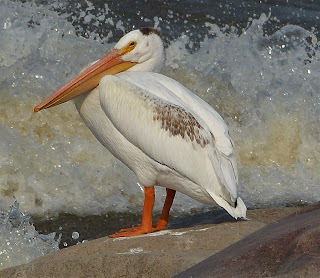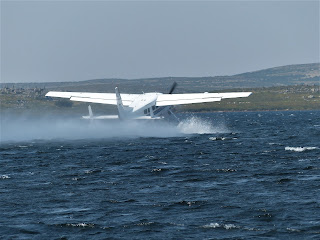All my life, I've been interested in animals, the outdoors, and the North. As a boy, under the influence of writers such as Ernest Thompson Seton and Vilhjalmur Stefansson, I dreamed of moving to the Arctic. When I was about 14, my father's cousin, a Scout Master in Nutley, New Jersey, and I canoed and camped in upstate New York and in the Boundary waters north of Minnesota. Later, at the University of Iowa, I canoed white water rivers in Wisconsin with a friend. We talked about taking a summer to canoe across Canada from the Rockies to Hudson Bay but life and better judgement got in the way. Then last year, I discovered a small ad in the back of The New Yorker for Canoe Arctic—guided canoeing in the Canadian Barrens. I corresponded with Alex Hall, the guide, and settled on a trip, August 5 to 16, on the Elk River, which he claimed was his favorite of the trips he ran.
Getting there was not easy. August 2, Deb and I flew Portland-Vancouver-Edmonton, laid over to the next day, then took a single engine plane 800 miles to Fort Smith, and the southern edge of the Northwest Territories, where we had arranged to stay at the Whooping Crane B&B for the two nights before the start of our canoe trip.
Near Ft. Smith, we toured the Salt Plains in Wood Buffalo National Park, a UNESCO World Heritage Site.
We found buffalo and grizzly tracks.
The air was hazy with smoke,
but some two hundred yards across the flats, sandhill cranes marched back and forth as they fed.
In Ft. Smith, we visited the Northern Life Museum, filled with artifacts from the region, and Canus, the rescued whooping crane largely responsible for the re-establishment of the species.
Deb hiked down to Slave River at the edge of town to see the White Pelicans that hang out at Rapids of the Drowned. She took these photos.
In the morning, we drove to the airport and loaded up two floatplanes.
Alex was joined by his sons, Graham and Evan.
Eleven were on the trip, with five canoes, leaving little room inside the planes.
We flew about 250 miles from Ft. Smith to Damant Lake, the last big lake at the headwaters of the Elk River. Our route, ten days on the river, is marked in red on the map.
The Barrens from the air: 220,000 square miles of tundra, swamp, lakes, and rivers stretching from Great Slave and Great Bear Lakes to Hudson Bay, north to the Arctic Ocean.
Elk River from the ground.
We unloaded the plane and set up camp for the night. The next day we loaded the canoes and started paddling across the lake.
As we approached the far shore, someone spotted a Musk Ox on a hill, some 200 or 300 yards away.
As each canoe beached, the paddlers jumped out and tried to sneak up on him, some of them down on all fours, trying to hide behind scarce bushes, probably looking like wolves, the only animal a Musk Ox might fear.
I dug the Leica out of its dry sack and managed a couple of shots before the others chased him over the hill.
We paddled down river, running a few rapids, portaging any that looked difficult.
The portages (pronounced by the Canadians por-TAHGE) involved carrying packs, food boxes, and canoes
up to half a mile over rocks, bushes, sand, bogs, and genereally bad footing—there were no trails—several times each portage to move all the gear. It was more than exhausting.
Each morning, we ate breakfast at 8—Alex's rule (he was quite punctual), either instant oatmeal or granola with powdered milk, then on the river about 9. Lunch was canned fish or peanut butter and jam on hardtack—rye crackers. We stopped about 4, set up camp, ate supper at 7 of freeze-dried soup and freeze-dried stew.
Deb and Tasha on the river. Deb fished the river, hooked a nice one but it got away. Here she's estimating how big it was.
Smoke obscured the sky every day but it made for interesting sunsets, which lingered late into the evening.
We hiked up to long ridges of sand and gravel—eskers—a distinctive feature of the Barrens. Eskers are deposits from rivers that flowed under glaciers (up to two miles thick) that covered the land. When the glaciers receded some 10,000 years ago, the deposits remained.
Deb fished a lake by one esker.
Land near eskers form a moonscape of sand and rock.
For centuries, herds of Barren Ground caribou migrated seasonally from the tundra to the taiga across this land. In 2011, a survey estimated that the Beverly herd, which traveled where we canoed, numbered 124,000. Today, only bones remain. The other Barren Ground herds have decreased as well.
Relics from the people who followed the caribou remain, and when Alex finds any, he hides them to show his clients.
The land is still rich in plants, small animals, and birds. Fireweed,
sand flower,
and mushroom.
Ptarmigan.
The ground squirrel was not shy at all.
After ten days on the river, the planes returned to take us back to Ft. Smith.
We were ready.
Getting there was not easy. August 2, Deb and I flew Portland-Vancouver-Edmonton, laid over to the next day, then took a single engine plane 800 miles to Fort Smith, and the southern edge of the Northwest Territories, where we had arranged to stay at the Whooping Crane B&B for the two nights before the start of our canoe trip.
Near Ft. Smith, we toured the Salt Plains in Wood Buffalo National Park, a UNESCO World Heritage Site.
We found buffalo and grizzly tracks.
The air was hazy with smoke,
but some two hundred yards across the flats, sandhill cranes marched back and forth as they fed.
In Ft. Smith, we visited the Northern Life Museum, filled with artifacts from the region, and Canus, the rescued whooping crane largely responsible for the re-establishment of the species.
Deb hiked down to Slave River at the edge of town to see the White Pelicans that hang out at Rapids of the Drowned. She took these photos.
In the morning, we drove to the airport and loaded up two floatplanes.
Alex was joined by his sons, Graham and Evan.
Eleven were on the trip, with five canoes, leaving little room inside the planes.
We flew about 250 miles from Ft. Smith to Damant Lake, the last big lake at the headwaters of the Elk River. Our route, ten days on the river, is marked in red on the map.
The Barrens from the air: 220,000 square miles of tundra, swamp, lakes, and rivers stretching from Great Slave and Great Bear Lakes to Hudson Bay, north to the Arctic Ocean.
Elk River from the ground.
We unloaded the plane and set up camp for the night. The next day we loaded the canoes and started paddling across the lake.
As we approached the far shore, someone spotted a Musk Ox on a hill, some 200 or 300 yards away.
As each canoe beached, the paddlers jumped out and tried to sneak up on him, some of them down on all fours, trying to hide behind scarce bushes, probably looking like wolves, the only animal a Musk Ox might fear.
I dug the Leica out of its dry sack and managed a couple of shots before the others chased him over the hill.
We paddled down river, running a few rapids, portaging any that looked difficult.
The portages (pronounced by the Canadians por-TAHGE) involved carrying packs, food boxes, and canoes
up to half a mile over rocks, bushes, sand, bogs, and genereally bad footing—there were no trails—several times each portage to move all the gear. It was more than exhausting.
Each morning, we ate breakfast at 8—Alex's rule (he was quite punctual), either instant oatmeal or granola with powdered milk, then on the river about 9. Lunch was canned fish or peanut butter and jam on hardtack—rye crackers. We stopped about 4, set up camp, ate supper at 7 of freeze-dried soup and freeze-dried stew.
Deb and Tasha on the river. Deb fished the river, hooked a nice one but it got away. Here she's estimating how big it was.
Smoke obscured the sky every day but it made for interesting sunsets, which lingered late into the evening.
We hiked up to long ridges of sand and gravel—eskers—a distinctive feature of the Barrens. Eskers are deposits from rivers that flowed under glaciers (up to two miles thick) that covered the land. When the glaciers receded some 10,000 years ago, the deposits remained.
Deb fished a lake by one esker.
Land near eskers form a moonscape of sand and rock.
For centuries, herds of Barren Ground caribou migrated seasonally from the tundra to the taiga across this land. In 2011, a survey estimated that the Beverly herd, which traveled where we canoed, numbered 124,000. Today, only bones remain. The other Barren Ground herds have decreased as well.
Relics from the people who followed the caribou remain, and when Alex finds any, he hides them to show his clients.
The land is still rich in plants, small animals, and birds. Fireweed,
sand flower,
and mushroom.
Ptarmigan.
The ground squirrel was not shy at all.
After ten days on the river, the planes returned to take us back to Ft. Smith.
We were ready.












































No comments:
Post a Comment